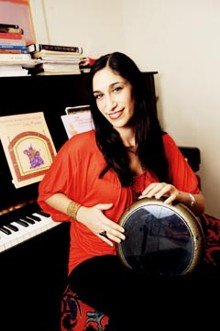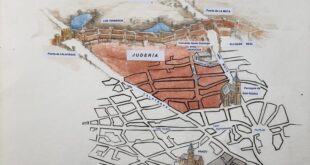From the Chest of Memories:
Singer Sarah Aroeste Corners the Market on Ladino Rock
 Sarah Aroeste is a woman on a mission. The 27-year-old singer, who mixes rock and pop influences with the Ladino music of her ancestors, isn’t just out to entertain. She wants to redefine the term “Jewish music.”
Sarah Aroeste is a woman on a mission. The 27-year-old singer, who mixes rock and pop influences with the Ladino music of her ancestors, isn’t just out to entertain. She wants to redefine the term “Jewish music.”
“When people think of Jewish music, I don’t think they think of sexy, necessarily,” said Aroeste, who has been described as “the Jewish Shakira” and who includes some belly-dancing as part of her live performances. “I think very few Jewish musicians are willing to express themselves in their music in a sensual way.”
Aroeste (whose name is pronounced “arrow-esty,” meaning “of the east”) was raised in Princeton, N.J., but traces her lineage to the Jews of Spain, who fled the Spanish Inquisition. After settling in Salonika, Greece, her ancestors maintained their Ladino heritage in songs and prayers. Her debut CD, “A La Una — In the Beginning,” has already sold out its initial, modest print run and is selling briskly over the Internet to fans as far away as Malta. She is drawing increasingly passionate crowds to her performances, and she is certain that her updated fusion has the potential to reach a wider audience than that of most traditionally Jewish music.
“When you hear klezmer it sounds very Jewish — which is wonderful,” she said. “But if you were to come to one of my shows, you wouldn’t necessarily know you were listening to Jewish music.” Indeed, on first listen to “A La Una,” the uninitiated might think the music was Greek, Spanish or Arabic. Amid the flash of flamenco acoustic guitars and the melodic thump of Arabic drums, “Jewish-sounding” is certainly not the first adjective that springs to mind.
“I have nothing against klezmer music,” she said, “but I want my music to be inclusive and a lot of my audiences are not exclusively Jewish. I’m trying to market it in a broad way. That’s why I have Middle Eastern instruments and band members, and yet there’s always a very Western feel. The enthusiasm from the audience and the fact that we’re getting really great bookings proves that there’s a thirst out there to learn more about this music.”
With the explosion in the popularity of world music, Aroeste may indeed have stumbled upon a fusion that no one else has yet hit upon. Tellingly, she doesn’t include any liturgical pieces in her repertoire. “I’m doing this project because I’m so inspired by my Jewish background,” she said, “but this is a secular project. It’s based on folk songs that could have been written yesterday. They’re about unrequited love, bad breakups, long-distance relationships. These are universal themes everyone can relate to. This music is so timeless and rich, it just breaks my heart that so few people know about it.”
Many of Aroeste’s songs are based on lush Spanish ballads called romanceros. When the Jews fled the Inquisition, they settled in countries in the Mediterranean basin and, over time, they created Ladino, a mix of Jewish Spanish, Ottoman, Moroccan and Mediterranean culture and influences melded into a single language now mainly known only to its few remaining practitioners and ethnomusicologists. But they picked up not only many of the linguistic elements that constitute Ladino, but also Eastern musical styles.
“My family ended up in Salonika, Greece, where there were a lot of Ottoman and Turkish cultural strands,” Aroeste said. “Most people who are using Ladino elements in their music are much older, and come from an ethnomusicologist tradition,” she said. “They are purists, they sing in a very folk, classical traditional style, which is beautiful — that’s what I grew up with and it’s how I learned the music — but I am also a young, hip, modern American woman. I have this really funky ethnic background, but I am also very Western and modern.”
Aroeste studied music at Yale and was classically trained in opera. A few years ago she decided to leave the opera world, finding it too stylistically rigid for her to express her own vision. She began working for the National Foundation for Jewish Culture, a New York-based national arts foundation focusing on Jewish arts and humanities. While there, she assembled The New Jewish Musics Initiative. “We found there were these incredible new trends happening in Jewish music,” she said. “The klezmer fusion renaissance was happening, and so many incredible styles were coming out: John Zorn, Anthony Coleman, the Klezmatics. But it was Ashkenazi-centric. There was very little being done that was new and innovative with Sephardic music. On one hand, I was inspired by how cool it was to be a Jewish musician, but there was no counterpart happening in the Sephardic community.”
Aroeste decided to take it on herself. “I wanted to be able to put something into my CD player that I would want to listen to,” she said, “and I couldn’t find other Ladino singers out there who were doing contemporary things with the music.”
So, in 2001, Aroeste assembled a band, “just for fun,” and began by rearranging the folk songs she grew up on. “It wasn’t an easy decision to start a Ladino rock band,” she said. “A lot of people thought I was crazy, because what would the demographic be? It was really hard to convince people that it would work. So I struggled for a year to put the music and the group together and find a balance that I thought could work.”
Her band is an unusual polyglot of Christian, Jewish and Muslim musicians — Arabs, Israelis and Westerners with a rare capacity to harmonize. “In putting together my music, I really draw on both East and West. The Western part comes from the original folk songs, the language — which is basically Castilian Spanish — and the instrumentation, which is electric guitar and bass. But a lot of my beats and melodies are Middle Eastern.”
Not surprisingly, Aroeste has now more or less cornered the market on Ladino rock in North America. Purists won’t necessarily love what Aroeste is doing with Ladino, but her goal is to reach a younger generation. She struggles to maintain the integrity of the tradition even as she updates it, relying on original melodies and lyrics, and fusing them to pop-rock arrangements. “I use an acoustic ethnic oud right next to an electric guitar,” she said laughing. “It’s a rare combination, but that’s who I am.”
In 1927, before immigrating to America, Aroeste’s family built a synagogue in Salonika. Today it is the only synagogue that remains in the city; the building wasn’t destroyed by the Nazis because they used it as a Red Cross center. During the Holocaust, 98% of the Jewish population of Salonika was killed — one of the highest rates of destruction. “The buildings are deteriorating because the Jewish population there is so old, no one is left to take care of the buildings and the Jewish life there,” Aroeste said. “People just don’t give attention to this part of Jewish culture. I’m so in love with music and the culture, and it just breaks my heart that not so many people know about it.”
Read more: http://forward.com/articles/7913/jewish-shakira-gives-her-songs-a-sexy-spin/#ixzz22IuNO6KH
Source: The Jewish Daily Forward
By Dimitri Ehrlich
Published August 15, 2003, issue of August 15, 2003.
 eSefarad Noticias del Mundo Sefaradi
eSefarad Noticias del Mundo Sefaradi

